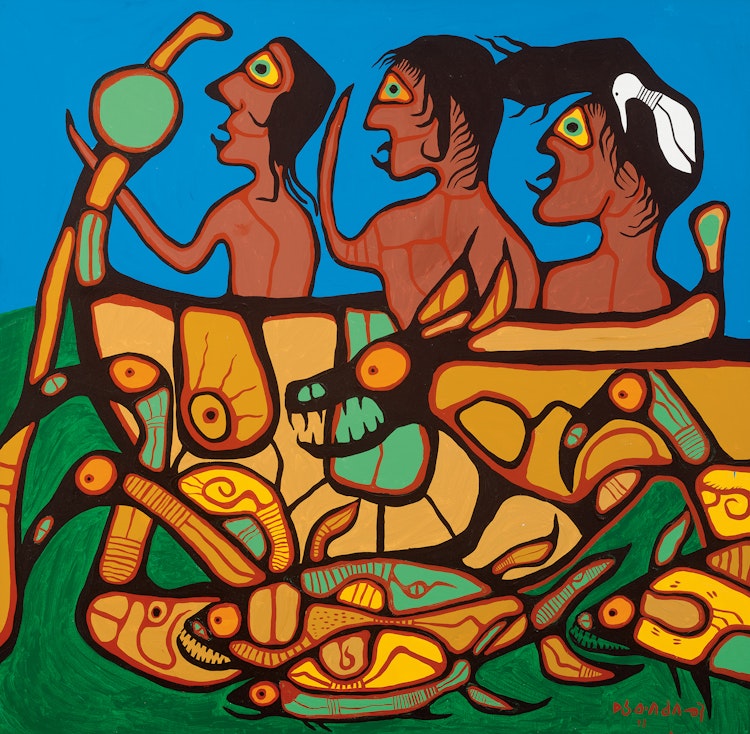Migrating, 1978 by Norval Morrisseau

Norval Morrisseau
Migrating, 1978
acrylic on canvas
signed in syllabics and dated 1978 lower right
52 x 53 ins ( 132.1 x 134.6 cms )
Auction Estimate: $40,000.00 - $60,000.00
Price Realized $108,000.00
Sale date: December 6th 2023
The Pollock Gallery, Toronto
Private Collection, Toronto
Lister Sinclair and Jack Pollock, “The Art of Norval Morrisseau”, Toronto, 1979, pages 116, 133, reproduced page 152
Armand Garnet Ruffo, “Norval Morrisseau, Man Changing into Thunderbird”, British Columbia, 2014, pages 196 and 198
As Jack Pollock reflected, “As soon as Morrisseau joined the Eckankar movement in 1976, he gave up drinking altogether. Not an easy task.” The artist’s use of colour became bolder and brighter in his later paintings of the 1970s. As Armand Garnet Ruffo writes of Morrisseau, “a light goes on that illuminates the world and confirms everything taught to him by his grandfather Potan all those years ago. He connects Eckankar’s emphasis on soul travel through the astral planes to his traditional Ojibway teachings.” Morrisseau began to deeply explore myths and legends, reinventing them from the various worlds of the Great Ojibway.
Throughout his career, Morrisseau repeatedly used the same classic, balanced compositional forms. The subjects are often depicted in a pyramid, with a central, symmetrical arrangement of figures or groupings balanced on the ground of the work, as exemplified in “Migrating” of 1978. Painted two years after his exposure to this new belief system, “Migrating” pays homage to the Anishinaabe oral account of the journey of the Ojibwe in the historic 500 year migration from the northeastern shores of North America to the Great Lakes region, as recorded in the prophecies, “The Seven Fires”. Migrating is a delightfully rich composition, complete with important historical and spiritual references and executed in Morrisseau’s quintessentially bright palette of this seminal period.
Share this item with your friends
Norval Morrisseau
(1932 - 2007) RCA, Order of Canada
Norval Morrisseau (also Miskwaabik Animiiki in Anishinaabemowin , meaning "copper thunderbird "), CM, was born in 1932 in northern Ontario. Norval Morrisseau was a self-taught artist of Ojibwe ancestry . He is best known for creating the contemporary Indigenous art movement called the "Woodland School." His deep spirituality and cultural connections guided his career, which spanned five decades. Morrisseau is now considered a pioneer among contemporary Indigenous artists in Canada.
Norval Morrisseau grew up on the Sand Point Reserve (now the Bingwi Neyaashi Anishinaabe First Nation ), on the southeast shore of Lake Nipigon . The first of five children, he was raised by his maternal grandparents. His grandfather, a shaman , taught him Anishinaabe culture and spirituality , while his grandmother taught him the Catholic religion . These two perspectives would greatly influence his future work. At the age of six, Norval Morrisseau was sent to St. Joseph's Indian Residential School in Fort William , Ontario. These schools, which removed Indigenous children from their families, prohibited traditional ceremonies and cultural expression. He later attended a public school near Beardmore, before leaving school for good at the age of 10.
At the age of 19, Norval Morrisseau fell seriously ill. His family held a healing ceremony, during which he was given the name Miskwaabik Animiiki , meaning copper thunderbird . The thunderbird appears in several of his works, such as Untitled (The Transformation of the Thunderbird) , produced around 1958–1960, and Man Transforming into a Thunderbird (1977), composed of six panels.
Norval Morrisseau is the originator of the pictographic style, commonly known as the Woodland School, which revitalized Anishnabe iconography, traditionally incised on rocks and Midewiwin birchbark scrolls. . This style is also sometimes referred to as "X-ray" art because of its emphasis on the outline of people, creatures, and objects. The Woodland School, which fused European and Ojibwe painting styles, relied on the use of bold colors. Although Norval Morrisseau painted primarily on birch bark, many artists after him painted on wood, canvas, and paper, using materials such as acrylic, watercolor, and gouache. Several well-known Indigenous artists employed this style, including Daphne Odjig , Jackson Beardy , and Alex Janvier .
In 1962, Susan Ross, a friend of Norval Morrisseau, approached Jack Pollock of the Pollock Gallery in Toronto to discuss the young artist's work. After meeting him and viewing his work, Pollock agreed to exhibit his work. The artist thus became the first Indigenous person in Canada to have their work presented in a contemporary art gallery. At the time, few Indigenous people were producing works intended to be included and displayed in mainstream society. Most Indigenous creations were analyzed from an anthropological perspective and not as works of modern art.
In 1965, some of his works were displayed at the Glenbow Museum in Calgary , and the following year were exhibited at what is now known as the Musée national des beaux-arts du Québec . It was in the 1960s that the painter succeeded in positioning himself as a significant contemporary Indigenous artist and paving the way for other Indigenous creators.
A self-taught painter, printmaker, and illustrator, Morrisseau created an innovative vocabulary which was initially criticized in the Indigenous community for its disclosure of traditional spiritual knowledge. Morrisseau completed many commissions during his career including the mural for the Indians of Canada Pavilion at Expo 67. He was made a member of the Order of Canada in 1978 and, in 1980, received honourary doctorates from both McGill and McMaster universities. In 1995 Morrisseau was honoured by the Assembly of First Nations. The artist died on December 4th, 2007 in Toronto.

